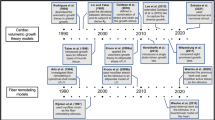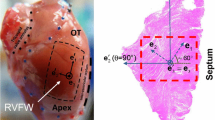Abstract
Myocardial infarction (MI) results in cardiac myocyte death and the formation of a fibrotic scar in the left ventricular free wall (LVFW). Following an acute MI, LVFW remodeling takes place consisting of several alterations in the structure and properties of cellular and extracellular components with a heterogeneous pattern across the LVFW. The normal function of the heart is strongly influenced by the passive and active biomechanical behavior of the LVFW, and progressive myocardial structural remodeling can have a detrimental effect on both diastolic and systolic functions of the LV leading to heart failure. Despite important advances in understanding LVFW passive remodeling in the setting of MI, heterogeneous remodeling in the LVFW active properties and its relationship to organ-level LV function remain understudied. To address these gaps, we developed high-fidelity finite-element (FE) rodent computational cardiac models (RCCMs) of MI using extensive datasets from MI rat hearts representing the heart remodeling from one-week (1-wk) to four-week (4-wk) post-MI timepoints. The rat-specific models (n = 2 for each timepoint) integrate detailed imaging data of the heart geometry, myocardial fiber architecture, and infarct zone determined using late gadolinium enhancement prior to terminal measurements. The computational models predicted a significantly higher level of active tension in remote myocardium in early post-MI hearts (1-wk post-MI) followed by a return to near the control level in late-stage MI (3- and 4-wk post-MI). The late-stage MI rats showed smaller myofiber ranges in the remote region and in-silico experiments using RCCMs suggested that the smaller fiber helicity is consistent with lower contractile forces needed to meet the measured ejection fractions in late-stage MI. In contrast, in-silico experiments predicted that collagen fiber transmural orientation in the infarct region has little influence on organ-level function. In addition, our MI RCCMs indicated that reduced and potentially positive circumferential strains in the infarct region at end-systole can be used to infer information about the time-varying properties of the infarct region. The detailed description of regional passive and active remodeling patterns can complement and enhance the traditional measures of LV anatomy and function that often lead to a gross and limited assessment of cardiac performance. The translation and implementation of our model in patient-specific organ-level simulations offer to advance the investigation of individualized prognosis and intervention for MI.








Similar content being viewed by others
References
Arunachalam, S. P., et al. Regional assessment of in vivo myocardial stiffness using 3D magnetic resonance elastography in a porcine model of myocardial infarction. Magn. Reson. Med. 79:361–369, 2018. https://doi.org/10.1002/mrm.26695.
Avazmohammadi, R., et al. An integrated inverse model-experimental approach to determine soft tissue three-dimensional constitutive parameters: application to post-infarcted myocardium. Biomech. Modeling Mechanobiol. 17:31–53, 2018.
Avazmohammadi, R., et al. A computational cardiac model for the adaptation to pulmonary arterial hypertension in the rat. Ann. Biomed. Eng. 47:138–153, 2019. https://doi.org/10.1007/s10439-018-02130-y.
Avazmohammadi, R., et al. A contemporary look at biomechanical models of myocardium. Annu. Rev. Biomed. Eng. 21:417–442, 2019.
Avazmohammadi, R., et al. On the in vivo systolic compressibility of left ventricular free wall myocardium in the normal and infarcted heart. J. Biomech. 107:109767, 2020.
Avazmohammadi, R., M. R. Hill, M. A. Simon, W. Zhang, and M. S. Sacks. A novel constitutive model for passive right ventricular myocardium: evidence for myofiber–collagen fiber mechanical coupling. Biomech. Modeling Mechanobiol. 16:561–581, 2017.
Bachner-Hinenzon, N., et al. Strain analysis in the detection of myocardial infarction at the acute and chronic stages. Echocardiography. 33:450–458, 2016. https://doi.org/10.1111/echo.13079.
Bovendeerd, P., T. Arts, J. Huyghe, D. van Campen, and R. Reneman. Dependence of local left ventricular wall mechanics on myocardial fiber orientation: a model study. J. Biomech. 25:1129–1140, 1992. https://doi.org/10.1016/0021-9290(92)90069-D.
Chan, J., et al. Differentiation of subendocardial and transmural infarction using two-dimensional strain rate imaging to assess short-axis and long-axis myocardial function. J. Am. Coll. Cardiol. 48:2026–2033, 2006. https://doi.org/10.1016/j.jacc.2006.07.050.
Chen, J., D. K. Ceholski, L. Liang, K. Fish, and R. J. Hajjar. Variability in coronary artery anatomy affects consistency of cardiac damage after myocardial infarction in mice. Am. J. Physiol. Circ. Physiol. 313:H275–H282, 2017. https://doi.org/10.1152/ajpheart.00127.2017.
Collier, P., D. Phelan, and A. Klein. A test in context: myocardial strain measured by speckle-tracking echocardiography. J. Am. Coll. Cardiol. 69:1043–1056, 2017. https://doi.org/10.1016/j.jacc.2016.12.012.
Dandel, M., H. Lehmkuhl, C. Knosalla, N. Suramelashvili, and R. Hetzer. Strain and strain rate imaging by echocardiography—basic concepts and clinical applicability. Curr. Cardiol. Rev. 5:133–148, 2009. https://doi.org/10.2174/157340309788166642.
Eriksson, T., A. Prassl, G. Plank, and G. Holzapfel. Influence of myocardial fiber/sheet orientations on left ventricular mechanical contraction. Math. Mech. Solids. 18:592–606, 2013. https://doi.org/10.1177/1081286513485779.
Espe, E. K., et al. Regional dysfunction after myocardial infarction in rats. Circ. Cardiovasc. Imaging. 10:e005997, 2017. https://doi.org/10.1161/CIRCIMAGING.116.005997.
Feild, B. J., R. O. Russell, J. T. Dowling, and C. E. Rackley. Regional left ventricular performance in the year following myocardial infarction. Circulation. 46:679–689, 1972. https://doi.org/10.1161/01.CIR.46.4.679.
Fomovsky, G., A. Rouillard, and J. Holmes. Regional mechanics determine collagen fiber structure in healing myocardial infarcts. J. Mol. Cell. Cardiol. 52:1083–1090, 2012.
Gaasch, W. H., and M. R. Zile. Left ventricular structural remodeling in health and disease: with special emphasis on volume, mass, and geometry. J. Am. Coll. Cardiol. 58:1733–1740, 2011. https://doi.org/10.1016/j.jacc.2011.07.022.
Gjesdal, O., et al. Noninvasive separation of large, medium, and small myocardial infarcts in survivors of reperfused st-elevation myocardial infarction. Circ. Cardiovasc. Imaging. 1:189–196, 2008. https://doi.org/10.1161/CIRCIMAGING.108.784900.
Glower, D., et al. Linearity of the frank-starling relationship in the intact heart: the concept of preload recruitable stroke work. Circulation. 71:994–1009, 1985.
Guccione, J. M., and A. D. McCulloch. Finite Element Modeling of Ventricular Mechanics. New York: Springer, 1991.
Holmes, J. W., T. K. Borg, and J. W. Covell. Structure and mechanics of healing myocardial infarcts. Annu. Rev. Biomed. Eng. 7:223–253, 2005. https://doi.org/10.1146/annurev.bioeng.7.060804.100453.
Holmes, J., J. Nuñez, and J. Covell. Functional implications of myocardial scar structure. Am. J. Physiol. Hear. Circ. Physiol. 272:H2123–H2130, 1997.
Hung, C.-L., et al. Longitudinal and circumferential strain rate, left ventricular remodeling, and prognosis after myocardial infarction. J. Am. Coll. Cardiol. 56:1812–1822, 2010. https://doi.org/10.1016/j.jacc.2010.06.044.
Hunter, P., A. McCulloch, and H. Ter Keurs. Modelling the mechanical properties of cardiac muscle. Prog. Biophys. Mol. Biol. 69:289–331, 1998.
Keshavarzian, M. et al. An image registration framework to estimate 3d myocardial strains from cine cardiac mri in mice. In: International Conference on Functional Imaging and Modeling of the Heart, Springer, New York, 2021, pp. 273–284.
Kupper, W., W. Bleifeld, P. Hanrath, D. Mathey, and S. Effert. Left ventricular hemodynamics and function in acute myocardial infarction: studies during the acute phase, convalescence and late recovery. Am. J. Cardiol. 40:900–905, 1977.
Lessick, J., et al. Regional three-dimensional geometry and function of left ventricles with fibrous aneurysms. A cine-computed tomography study. Circulation. 84:1072–1086, 1991. https://doi.org/10.1161/01.CIR.84.3.1072.
Li, D. S., et al. Insights into the passive mechanical behavior of left ventricular myocardium using a robust constitutive model based on full 3d kinematics. J. Mech. Behav. Biomed. Mater. 103:103508, 2020.
Li, D. S., et al. How hydrogel inclusions modulate the local mechanical response in early and fully formed post-infarcted myocardium. Acta Biomater. 114:296–306, 2020.
Liu, H., et al. Distribution pattern of left-ventricular myocardial strain analyzed by a cine MRI based deformation registration algorithm in healthy chinese volunteers. Sci. Rep. 28:45314, 2017. https://doi.org/10.1038/srep45314.
Liu, W. et al. Multiscale contrasts between the right and left ventricle biomechanics in healthy adult sheep and translational implications. Front. Bioeng. Biotechnol. 10, 2022.
Liu, W., et al. Strain-dependent stress relaxation behavior of healthy right ventricular free wall. Acta Biomater. 152:290–299, 2022.
Liu, H., et al. The impact of myocardial compressibility on organ-level simulations of the normal and infarcted heart. Sci. Rep. 11:1–15, 2021.
Mangion, K., et al. Circumferential strain predicts major adverse cardiovascular events following an acute ST-segment–elevation myocardial infarction. Radiology. 290:329–337, 2019. https://doi.org/10.1148/radiol.2018181253.
McGarvey, J. R., et al. Temporal changes in infarct material properties: an in-vivo assessment using magnetic resonance imaging and finite element simulations. Ann. Thorac. Surg. 100:582–589, 2015. https://doi.org/10.1016/j.athoracsur.2015.03.015.
McKay, R. G., et al. Left ventricular remodeling after myocardial infarction: a corollary to infarct expansion. Circulation. 74:693–702, 1986. https://doi.org/10.1161/01.CIR.74.4.693.
Mendiola, E., et al. Identification of infarct border zone using late gadolinium enhanced MRI in rats. FASEB J. 36:6220, 2022. https://doi.org/10.1096/fasebj.2022.36.S1.R6220.
Mendiola, E. A., M. S. Sacks, and R. Avazmohammadi. Mechanical interaction of the pericardium and cardiac function in the normal and hypertensive rat heart. Front. Physiol. 838, 2022.
Neelakantan, S., et al. Abstract 14303: structural remodeling in the left ventricular myocardium underlies systolic dysfunction in myocardial infarction. Circulation. 144:A14303–A14303, 2021. https://doi.org/10.1161/circ.144.suppl_1.14303.
Neelakantan, S. et al. Stress relaxation behavior of left ventricular myocardium in mice. FASEB J. 36, 2022.
Nicolosi, A. C., and H. M. Spotnitz. Quantitative analysis of regional systolic function with left ventricular aneurysm. Circulation. 78:856–862, 1988. https://doi.org/10.1161/01.CIR.78.4.856.
Omens, J. H., T. R. Miller, and J. W. Covell. Relationship between passive tissue strain and collagen uncoiling during healing of infarcted myocardium. Cardiovasc. Res. 33:351–358, 1997. https://doi.org/10.1016/S0008-6363(96)00206-4.
Pfeffer, M. A., and E. Braunwald. Ventricular remodeling after myocardial infarction. Experimental observations and clinical implications. Circulation. 81:1161–1172, 1990. https://doi.org/10.1161/01.CIR.81.4.1161.
Reindl, M., et al. Prognostic implications of global longitudinal strain by feature-tracking cardiac magnetic resonance in st-elevation myocardial infarction. Circ. Cardiovasc. Imaging. 12:e009404, 2019. https://doi.org/10.1161/CIRCIMAGING.119.009404.
Richardson, W. J., S. A. Clarke, T. A. Quinn, and J. W. Holmes. Physiological implications of myocardial scar structure. Compr. Physiol. 5:1877–1909, 2018. https://doi.org/10.1002/cphy.c140067.
Soepriatna, A. H., et al. Three-dimensional myocardial strain correlates with murine left ventricular remodelling severity post-infarction. J. R. Soc. Interface. 16:20190570, 2019. https://doi.org/10.1098/rsif.2019.0570.
Sutton, M. G. S. J., and N. Sharpe. Left ventricular remodeling after myocardial infarction. Circulation. 101:2981–2988, 2000. https://doi.org/10.1161/01.CIR.101.25.2981.
Torres, W. M., et al. Regional and temporal changes in left ventricular strain and stiffness in a porcine model of myocardial infarction. Am. J. Physiol. Circ. Physiol. 315:H958–H967, 2018.
van den Borne, S., et al. Myocardial remodeling after infarction: the role of myofibroblasts. Nat. Rev. Cardiol. 7:30–37, 2009. https://doi.org/10.1038/nrcardio.2009.199.
Verma, A., et al. Prognostic implications of left ventricular mass and geometry following myocardial infarction: the valiant (valsartan in acute myocardial infarction) echocardiographic study. Cardiovasc. Imaging. 1:582–591, 2008. https://doi.org/10.1016/j.jcmg.2008.05.012.
Wenk, J. F., et al. A novel method for quantifying the in-vivo mechanical effect of material injected into a myocardial infarction. The Ann. Thorac. Surg. 92:935–941, 2011. https://doi.org/10.1016/j.athoracsur.2011.04.089.
Xi, J., et al. The estimation of patient-specific cardiac diastolic functions from clinical measurements. Med. Image Anal. 17:133–146, 2013. https://doi.org/10.1016/j.media.2012.08.001.
Yingchoncharoen, T., S. Agarwal, Z. B. Popovic, and T. H. Marwick. Normal ranges of left ventricular strain: a meta-analysis. J. Am. Soc. Echocardiogr. 26:185–191, 2012. https://doi.org/10.1016/j.echo.2012.10.008.
Zimmerman, S. D., W. J. Karlon, J. W. Holmes, J. H. Omens, and J. W. Covell. Structural and mechanical factors influencing infarct scar collagen organization. Am. J. Physiol. Circ. Physiol. 278:H194–H200, 2000.
Acknowledgments
This research was supported in part by the National Institutes of Health Grant No. R00HL138288 to R.A.
Author information
Authors and Affiliations
Corresponding author
Ethics declarations
Competing interests
The authors declare no conflict of interest.
Additional information
Associate Editor Stefan M. Duma oversaw the review of this article.
Publisher's Note
Springer Nature remains neutral with regard to jurisdictional claims in published maps and institutional affiliations.
Supplementary Information
Below is the link to the electronic supplementary material.
Rights and permissions
Springer Nature or its licensor (e.g. a society or other partner) holds exclusive rights to this article under a publishing agreement with the author(s) or other rightsholder(s); author self-archiving of the accepted manuscript version of this article is solely governed by the terms of such publishing agreement and applicable law.
About this article
Cite this article
Mendiola, E.A., Neelakantan, S., Xiang, Q. et al. Contractile Adaptation of the Left Ventricle Post-myocardial Infarction: Predictions by Rodent-Specific Computational Modeling. Ann Biomed Eng 51, 846–863 (2023). https://doi.org/10.1007/s10439-022-03102-z
Received:
Accepted:
Published:
Issue Date:
DOI: https://doi.org/10.1007/s10439-022-03102-z




